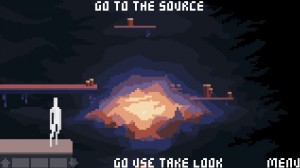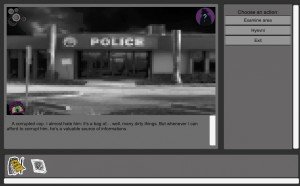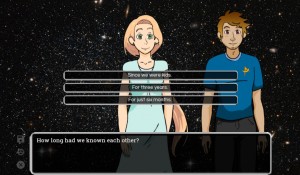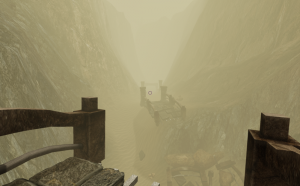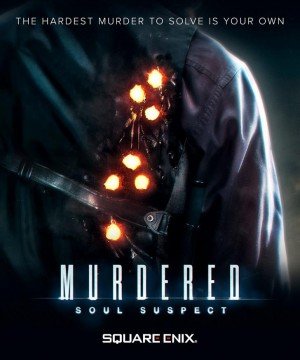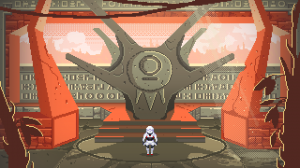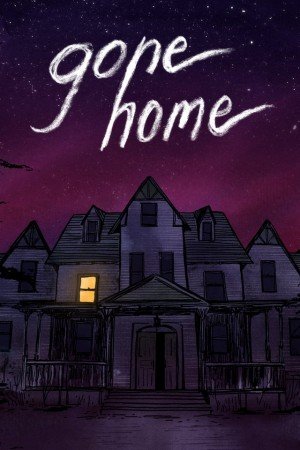Following Freeware - March 2015 releases page 2
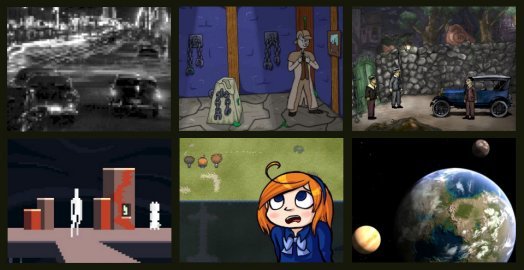
This month you can play as a private eye looking for a missing person, or as a canine sleuth modelled on a famous detective. You might want to travel to the far reaches of space with some pioneering colonists, or journey into the twisted worlds of a young girl’s painting. You could also join three peculiar children trying to escape a creepy factory or a trio of villains who may just have chosen the wrong target for their latest crime. Alternatively, you can take on the role of a protagonist who knows with absolute certainty who he is. All these await in this month’s round-up of releases from the freeware scene.
Steve’s Selections
Sleuthhounds: The Unlocked Room
Famous consulting detective, Pureluck Homes, has received an invitation to another case. Unfortunately, on his way to start work on this mystery, he has been waylaid. Waking up chained to the wall in a basement, Pureluck must use all of his wits and cunning if he is to escape. With his mysterious captor almost encouraging him over a remote speaker system, just why has he been kidnapped in the first place?
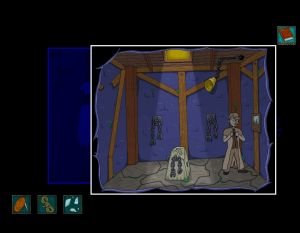 As an introductory adventure for their proposed Sleuthhounds series, SeaLeft Studios’ The Unlocked Room presents a genteel mystery. The presentation features a cartoon style, with locations and individuals presented in comic panels. New panels are placed overlapping the previous ones, with the old panels turning to deep shades of blue to form a new background. The graphics are reasonably detailed, with lighting effects and shading to give the scenery depth. You start in a brick-walled dungeon, but will later visit more auspicious locations. As the title suggests, the lead character is an anthropomorphic dog, decked out in a long coat and deerstalker hat. Both he and his captor are smoothly animated, whether simply walking about or engaging in physical exertion. They have expressive faces as well, such as Pureluck being clearly perturbed by his predicament at the start. Both are also both fully voiced to a high standard, with highly refined accents. Classically-styled string music provides the background to proceedings. There are also appropriate sound effects, such as the clinking of your chains.
As an introductory adventure for their proposed Sleuthhounds series, SeaLeft Studios’ The Unlocked Room presents a genteel mystery. The presentation features a cartoon style, with locations and individuals presented in comic panels. New panels are placed overlapping the previous ones, with the old panels turning to deep shades of blue to form a new background. The graphics are reasonably detailed, with lighting effects and shading to give the scenery depth. You start in a brick-walled dungeon, but will later visit more auspicious locations. As the title suggests, the lead character is an anthropomorphic dog, decked out in a long coat and deerstalker hat. Both he and his captor are smoothly animated, whether simply walking about or engaging in physical exertion. They have expressive faces as well, such as Pureluck being clearly perturbed by his predicament at the start. Both are also both fully voiced to a high standard, with highly refined accents. Classically-styled string music provides the background to proceedings. There are also appropriate sound effects, such as the clinking of your chains.
Whilst the tone is of a humorous Sherlock Holmes spoof, this game provides an intriguing challenge. Interaction is all done by mouse, with right-click looking and left-click interacting. There is also a small inventory, in which clicking an item highlights it, resulting in Pureluck attempting to use it on the next hotspot you interact with. With the only exit a hatchway high above your head, escape from the initial room will require thorough examination of your surroundings, and a bit of clever item combination. In a later room there is also a separate deduction mode. In this, an item or person is shown on the right and the observations and deductions you have made appear on the left. Examining said person or object closely elicits more clues. These are represented as jigsaw puzzle pieces, and attempting to fit them together allows you to deduce more. As well as those progressing the main plot, there are optional side puzzles to solve, such as some word puzzles presented to you by your captor. There are three difficulty levels, with puzzles made easier and more help given on lower levels. Extra content is unlocked by completing the game, with more obtained by solving more puzzles at higher levels.
Sleuthhounds: The Unlocked Room can be downloaded from the developer’s website.
Living Playground
For siblings Tony, Octavio and Pablo, the grounds outside an abandoned factory seemed the ideal place to hunt for snails, until they were ambushed by a strange mechanical creature that appeared out of nowhere. Waking up to find herself alone inside the factory, Tony sets out in search of her missing brothers. As she explores the decrepit old building, it becomes clear that there is more wrong with it than just age. What is more, the tale of the factory seems to tie into her own past, and the strange transformative abilities she and her brothers have. As she ascends higher seeking a way out, will she survive the perils that await her?
 Meaka’s Living Playground is a surreal and disquieting experience. The presentation uses a top-down role-playing game style. Tony is presented as a squat figure, though a more detailed anime cartoon version of her is shown during conversation. Though static, these dialogue portraits show varied expressions appropriate to the words being spoken. The protagonist is simply animated, as are a handful of things around the factory. The building has definitely seen better days, with plants growing on some walls and holes in the wooden floorboards. As you progress further, the building becomes more bizarre and otherwordly in nature. Varied music plays throughout, from a slow and subtly disturbing piece at the start to a more frenetic tune when impending danger threatens. A variety of sound effects, mostly related to the machinery you operate, are also in evidence.
Meaka’s Living Playground is a surreal and disquieting experience. The presentation uses a top-down role-playing game style. Tony is presented as a squat figure, though a more detailed anime cartoon version of her is shown during conversation. Though static, these dialogue portraits show varied expressions appropriate to the words being spoken. The protagonist is simply animated, as are a handful of things around the factory. The building has definitely seen better days, with plants growing on some walls and holes in the wooden floorboards. As you progress further, the building becomes more bizarre and otherwordly in nature. Varied music plays throughout, from a slow and subtly disturbing piece at the start to a more frenetic tune when impending danger threatens. A variety of sound effects, mostly related to the machinery you operate, are also in evidence.
This is a horror game, though generally more psychological than visceral in tone. Control is handled through the keyboard, with arrow keys for movement and the space bar to interact. There is also an inventory, called up with X, that allows you to examine the objects collected and transform temporarily into another shape. Inventory application is automatic when appropriate, without needing to open this screen. As you explore you will search out keys, operate levers and solve mazes. The latter provide some interesting variety, with one maze having walls hazardous to the touch, and another with invisible pathways the player must map. There is also a single sound-based puzzle. A handful of rooms have dangerous creatures in them, but they generally move slowly and without taking notice of you, thus being easily avoided. On two occasions a creature will actively pursue you and some dexterity will be needed to evade pursuit. An early task activates a save point, and there are similar save points available at regular intervals thereafter. As death is possible, it is advisable to make use of these.
Living Playground can be downloaded from the RPG Maker website. The game also requires the RPG Maker XP Run Time Package to play.
Bevel’s Painting
For young Bevel, painting has always been a way to escape from the mundane world around her. But today that escape has become all too literal, as she finds herself falling into one of her own paintings. Working her way through a series of worlds, each focussed on a particular colour, she finds herself facing strange and disturbing imagery. As the worlds become more threatening, will Bevel live to see her own world again?
 In Bevel’s Painting Maninu has created a disquieting and decidedly surreal experience. Graphical presentation uses a retro top-down role-playing game style. The lead character is presented as a young girl in a blue dress with a striking red beret. The locales you visit range from the mundane, such as a hallway lined with black-and-white tiles, to the bizarre, including a room containing a giant heart surrounded by skulls. Bevel and the handful of other characters she encounters are decently animated, and there are some nice visual effects, like the reflection of the protagonist in a highly polished floor. Audio varies according to the overall feel of an area. An area set up like a house has a soothing piano background, whereas a dark maze is filled with the almost indiscernible sound of something breathing.
In Bevel’s Painting Maninu has created a disquieting and decidedly surreal experience. Graphical presentation uses a retro top-down role-playing game style. The lead character is presented as a young girl in a blue dress with a striking red beret. The locales you visit range from the mundane, such as a hallway lined with black-and-white tiles, to the bizarre, including a room containing a giant heart surrounded by skulls. Bevel and the handful of other characters she encounters are decently animated, and there are some nice visual effects, like the reflection of the protagonist in a highly polished floor. Audio varies according to the overall feel of an area. An area set up like a house has a soothing piano background, whereas a dark maze is filled with the almost indiscernible sound of something breathing.
This is not a game for the faint-hearted, as many unpleasant surprises await our heroine. Keyboard controls are used, with arrow keys to move around and Z to interact. The first world starts off gently with just some simple puzzle-solving, including sliding blocks around and collecting some inventory. Later worlds add more difficulty, with some housing denizens actively seeking to thwart you. As you progress things get more horrific, and you will need to act quickly to avoid death on occasion. You will also find yourself having to engage in some less-than-pleasant actions to progress. A recurring action is to acquire paint on your brush, which is needed to advance to further worlds. There are also numerous messages written in a symbolic font, Bevelese, which can be translated by hand once you have found the key to their meaning. Save points are scattered throughout the game in the form of laptop computers and regular use is advised. A total of nine endings are available, with a bonus level unlocked by achieving the best ending.
Bevel’s Painting can be downloaded from the developer’s website.
IAMJASON
The world is falling apart, everything falling to corruption. Automated systems continue to attempt to repair the damage, but their efforts are in vain. As I despaired, news came to me of the source of the corruption. Now I seek to make my way into the lower levels to bring an end to that source. Whilst my wife and child may be lost and the world already in ruins, perhaps what is left can still be saved. I am Jason.
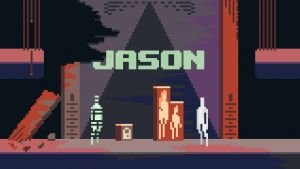 Made for the “Losing Something” MAGS challenge, Calico Reverie’s IAMJASON is minimalist but effective. The graphics are extremely pixelated, with the lead character a blocky white stick figure with no features at all. The scenery has a similar low-resolution presentation, using only a handful of colours. Despite this simplicity, clever use of shades and colour gives some depth to the scenery and renders important items clear. Matching the look of the graphics, the animation is also very basic, but effective within the context. Sound effects like the putter of the repair droids or the sparking of a broken cable are used throughout. There is also a slow tonal piece, reminiscent of early 8-bit games, that plays in the background. There is no speech, with Jason’s observations displayed in large capital letters on the screen one word at a time.
Made for the “Losing Something” MAGS challenge, Calico Reverie’s IAMJASON is minimalist but effective. The graphics are extremely pixelated, with the lead character a blocky white stick figure with no features at all. The scenery has a similar low-resolution presentation, using only a handful of colours. Despite this simplicity, clever use of shades and colour gives some depth to the scenery and renders important items clear. Matching the look of the graphics, the animation is also very basic, but effective within the context. Sound effects like the putter of the repair droids or the sparking of a broken cable are used throughout. There is also a slow tonal piece, reminiscent of early 8-bit games, that plays in the background. There is no speech, with Jason’s observations displayed in large capital letters on the screen one word at a time.
Control is handled using a single click with a verb list. The available actions are Go, Use, Take and Look, with Go being the default action. A small inventory is available, with the currently selected item becoming the default action for use on something else. A central location contains four platforms, initially unlinked. Different keys connect the platforms in different ways, allowing players to access new areas with each key obtained. There is also a cunning puzzle based around a walkway with pressure pads on it, and you will need to use the predictability of the automated repair droids against them on occasion to acquire the tools you need.
IAMJASON can be downloaded from the developer’s website.
Willem’s Winners
A Matter of Caos: Episodes 1 and 2
Mr. Gilbert, the protagonist in A Matter of Caos by Italian developer ExperaGameStudio, finds himself in exactly the same situation as so many private detectives who came before him. Poor, lonesome PI with money problems: check. Dark, forbidding city filled with Really Nasty People: check. Rich mysterious dame comes in with a job for you: check. Job requires searching for a missing person: check. The story is typical too: Gilbert gets a minimum of information about the girl his mysterious rich benefactor, Miss Malaguard, hires him to find. All he has is a picture, a name (Daphne) and the tip that she works as a waitress at the Trembling Stars. As clichéd as this premise might seem, however, Mr. Gilbert is not your average detective. He looks very much like an octopus: purple-colored and with tentacles for hands or feet. Gilbert is not the only strange creature in this adventure either. You will also meet a hellteeth (a dangerous dragon-like creature) and a very freaky and dangerous dog, amongst others.
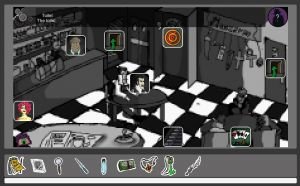 The nameless dark city setting is presented in static pseudo-first-person pixel art, drawn in shades of grey as befits its obvious noir influences. In his search for Daphne, Gilbert will visit a half-friendly bouncer in front of a shady pub, a rich man in his posh house, a sneaky and dangerous lawyer in a casino, and many more interesting places and characters, some of whom try to kill him, while others help him for their own reasons (they couldn't care less about Gilbert). Short hotspot descriptions appear in a translucent bar at the top of the screen, while dialogues and longer descriptions of items are displayed in a large overlay in the middle. During dialogue you can often choose your line from multiple options displayed on the screen. Conversations are accompanied by a portrait of the person speaking. There is no voice acting. However, there are some very neat sound effects, which enhance the atmosphere of the game greatly. Ominous music, the tune of which depends on the location, is played throughout the game.
The nameless dark city setting is presented in static pseudo-first-person pixel art, drawn in shades of grey as befits its obvious noir influences. In his search for Daphne, Gilbert will visit a half-friendly bouncer in front of a shady pub, a rich man in his posh house, a sneaky and dangerous lawyer in a casino, and many more interesting places and characters, some of whom try to kill him, while others help him for their own reasons (they couldn't care less about Gilbert). Short hotspot descriptions appear in a translucent bar at the top of the screen, while dialogues and longer descriptions of items are displayed in a large overlay in the middle. During dialogue you can often choose your line from multiple options displayed on the screen. Conversations are accompanied by a portrait of the person speaking. There is no voice acting. However, there are some very neat sound effects, which enhance the atmosphere of the game greatly. Ominous music, the tune of which depends on the location, is played throughout the game.
There isn’t much visual detail in most screens, often not even depicting all the objects you can manipulate. In Episode 1, a column positioned to the right of the viewable area shows a list of the things Gilbert can see, including things that you cannot. In Episode 2, the column is replaced by colorful icons placed over the appropriate locations in the environment. Clicking the items listed in the column (Ep. 1) or the icons directly (Ep. 2) with the left mouse button takes Gilbert to new locations, provides a description of the object or person, or places the item in his inventory, located at the bottom of the screen. Inventory items are brightly colored in both episodes, and an icon allows you to examine them in more detail. Whenever Gilbert writes something in his notebook, a big red exclamation mark flashes over it until you click on it. In the top right is an icon that gives access to Gilbert's thoughts, which sometimes helps to solve puzzles.
A Matter of Caos contains an eclectic mix of dialogue and inventory puzzles. Your life often depends on what you say to whom, so be careful. Of course, in a city like Gilbert’s, you will also have to outwit or slay the occasional monster. This means you will die often, but right after death the game lets you try again so it is not really a problem. Gilbert has special powers, used automatically, with which he can mellow people's minds and make them tell more than they intend. They don't always work well enough, however, so sometimes Gilbert has to resort to other ways of persuading people. Having no hands and legs, however, complicates matters in that regard. Apart from Gilbert's interesting powers and shortcomings, A Matter of Caos is a pretty standard detective story. But it is quite long and complicated, and very well worked out. The story unfolds logically and the puzzles are very well integrated and don't hold up progress unfairly.
This game is not suitable for young children, as it deals with prostitution, murder, horror and the occult. The characters you meet all have their own peculiarities and backgrounds, and you get to know many of them better as the game progresses. You have to play Episode 1 in one go, but you can save your game in Episode 2 in a single save slot. The second episode picks up exactly where the first stops, but if you take a break between them you can view a recap before you continue. So far, A Matter of Caos is proving to be a good, solid adventure series which you will enjoy for quite a few hours. The story is clearly not over yet (actually it looks like it's just beginning), so I'm waiting eagerly for Episode 3.
Both Episode 1 and Episode 2 of A Matter of Caos can be played online at Kongregate.
Our Personal Space
Life on earth is getting a bit boring for young Jack, so he takes his new wife Kelly to the Earth-like planet of Talaam, where a new colony is being started. Jack is a farmer, so he will be taking care of the food production there. Our Personal Space, by Metasepia Games, takes you through 25 Talaamian months with the couple. Life on a barren planet is not easy for the newlyweds, who feel like the pioneers who conquered the American West in the 1800s. They have to cope with a lack of resources, broken equipment, the usual quarrels and irregularities within the community, deaths and many more problems, hazards and annoyances.
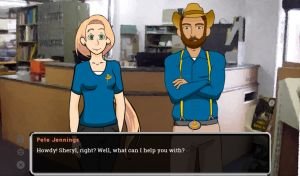 Our Personal Space is an interactive story complemented by pictures and sounds. The characters that are important to the scene are shown in a rather cartoony style over the top of vivid watercolor background paintings. The contrast in styles makes for a strange blend, as does the depiction of seemingly old-fashioned things in a futuristic sci-fi story. For instance, the stove Kelly and Jack use is supposedly a modern electricity/biomass hybrid unit but looks more like a stove from the 1800s. The discrepancy doesn't really matter though, because the story focuses mainly on the social implications that living in a small colony on a faraway planet have on the couple. The story is told via text in a black oblong box at the bottom of the screen. The background music consists of several piano tunes, and sometimes when appropriate the sound of wind, a waterfall or machinery running can be heard. All sounds are very clear and of good quality.
Our Personal Space is an interactive story complemented by pictures and sounds. The characters that are important to the scene are shown in a rather cartoony style over the top of vivid watercolor background paintings. The contrast in styles makes for a strange blend, as does the depiction of seemingly old-fashioned things in a futuristic sci-fi story. For instance, the stove Kelly and Jack use is supposedly a modern electricity/biomass hybrid unit but looks more like a stove from the 1800s. The discrepancy doesn't really matter though, because the story focuses mainly on the social implications that living in a small colony on a faraway planet have on the couple. The story is told via text in a black oblong box at the bottom of the screen. The background music consists of several piano tunes, and sometimes when appropriate the sound of wind, a waterfall or machinery running can be heard. All sounds are very clear and of good quality.
You play as Kelly, and often you will be presented with choices of what to say or do. The options you can choose from are displayed in the middle of the screen, and the story is mainly determined by your decisions. The number of choices you have to make is incredible. The game starts with a long introduction about how Kelly and Jack get married and move to Talaam. Here you can choose whether Kelly really feels like going with Jack or only does it to stay with him, what kind of job Kelly has on Earth, whether they will have a baby or not. You can even change the couple's default names if you wish. After the introduction, you are more or less settled on Talaam, and now have to wait two years for the next supply ship to arrive. In the meantime, you have to help to make the colony prosperous. This is where the game really begins. Every month Kelly has to decide what she will do and how she will spend her free time. She can work on one of no less than eight different skills like technological, domestic or physical skills every month, decide to focus on work or take it easy, and whether or not to spend her free time alone. These choices are presented on a screen showing Kelly's datapad at the beginning of every month. You can also read the colony message board there, listen to several tracks of music, and check out the status of Kelly and Jack's relationship.
After making all your choices the month starts, where you are forced to deal with more choices! Everything you decide has a profound impact on how the story goes and how Kelly and Jack's relationship develops. It even influences the way the characters appear on the screen. A choice can make them happy or sad or even make them walk away entirely. It's incredible how many things Kelly can do and say that influence the story. For instance, the job you choose for Kelly when she's still on Earth, and the things she will specialize in on Talaam can be very helpful for the community. But you could also make her a lazy bum and focus on nothing particular the whole time. You can make her and Jack's life incredible as easily as you can make it miserable, just by making the appropriate choices. Our Personal Space really can be just what you want it to be. Replaying the game can become repetitive and a bit boring, because you have to decide what Kelly will focus on 25 different times. But because the emergent stories are so rich and detailed, and often new things are uncovered, it was hard for me to stop playing. Luckily, every time you quit the game it auto saves, so you can easily continue later. Thanks to the incredible amount of influence you can have over the story without ever skipping a beat, Our Personal Space is a high quality interactive story that is worth a long look.
Our Personal Space can be downloaded from MetaSepia's website.
The Terrible Old Man
Three criminals enter a small coastal town's candle-lit tavern. They are new here, but they soon find out about a weird but very rich mad old man who lives near the seashore and pays everything in gold doubloons. That sounds promising, so the trio conceives of a cunning plan to overpower the old man and take his gold. However, things end up going a lot differently than they planned...
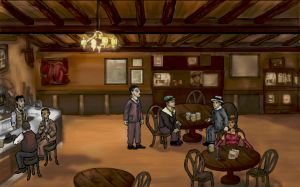 The short game The Terrible Old Man, developed by Cloak and Dagger Games for the March 2015 MAGS competition, is an interactive adaption of the story with the same name by H. P. Lovecraft. Set in the early 20th century, the whole game is presented in three beautifully drawn screens in rich colors. It's clear that great effort was put into the details: people move about in the background, the sea laps the shore, insects fly around a lantern and a soft and ominous tune plays during the game. There are also some convincing sound effects: a stone breaking a window, a lock being unlatched, and the like. There is no voice acting in The Terrible Old Man; all text is shown on screen with a mug shot of the speaker to the left of it. A neat feature is that the portraits are animated to show emotions while talking, though sometimes that looks a bit creepy.
The short game The Terrible Old Man, developed by Cloak and Dagger Games for the March 2015 MAGS competition, is an interactive adaption of the story with the same name by H. P. Lovecraft. Set in the early 20th century, the whole game is presented in three beautifully drawn screens in rich colors. It's clear that great effort was put into the details: people move about in the background, the sea laps the shore, insects fly around a lantern and a soft and ominous tune plays during the game. There are also some convincing sound effects: a stone breaking a window, a lock being unlatched, and the like. There is no voice acting in The Terrible Old Man; all text is shown on screen with a mug shot of the speaker to the left of it. A neat feature is that the portraits are animated to show emotions while talking, though sometimes that looks a bit creepy.
Even more effort was put into the dialogue, which is rich and clearly shows the relationships the three men have with each other. During conversation you sometimes have to choose what to say from choices that appear on the screen. While exploring you can click on almost anything you see and the protagonist Joe Czanek will tell you something about it. Right-clicking gives you a description of the object, while left-clicking makes Czanek interact with it. The inventory shows up when you move the cursor to the top of the screen. The Terrible Old Man is a fairly simple game with some easy inventory-based puzzles, but the great care with which it was made pours out of its limited environments, making for a very enjoyable ten minutes or so of play time. As with all Lovecraft stories, this one is not for children because it deals with intense fear and death.
The Terrible Old Man can be downloaded from the AGS website.
Other new releases
Not all games are created equal, and freeware games especially come in all shapes and sizes. Not to be overlooked, the following list might also be of interest, though these games may be significantly shorter or less polished, more experimental titles than those detailed above, some perhaps only borderline adventures to begin with.
I Can Feel It Coming by justdeleteit – As a young man clumsily tries to woo a girl at the fair, a military tribunal is convened.
Anita’s Job by Carmel Games – When one of her customer’s suitcases goes missing, it is the job of tour guide Anita to get it back.
You rock, Topus! by Billbis – Getting your girlfriend’s parents to accept you is tough when you’re half sea-creature.
Locked-In by Lucky Special Games – Jacqueline Brown has had an accident and is now in a hospital bed. Unable to move or speak but still able to hear, she must discover what happened to her in this visual novel with eight endings.
Cthulhu Science by sebbdk – A very funny story about a scientist who is locked up in a big glass jar.
That’s it for this month. Think we’ve missed a gem or want to tell us about your own game? Then pop in to our Adventure forum and tell us about it!
Article written by Stephen Brown and Willem Tjerkstra.






